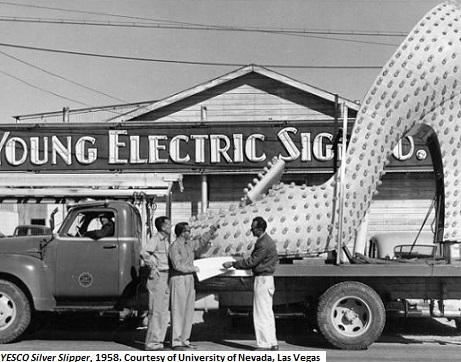Dublin Core
Title
Description
Main streets throughout postwar Utah depended on conspicuous signage to entice passersby to stop and shop. Learn how one Utah company used eye-catching neon to meet that demand.
Walk down any main street in Utah and you might notice relics of a recent past just above your head. Long before advertisements flooded Facebook, businesses lit up city streets with bright, flashy neon signs to bring in customers. In an era when neon became the most desirable medium for advertising in the American West, Utah’s Young Electric Sign Company – known as YESCO – became renowned for its signature neon creations.
YESCO began manufacturing neon tubing in the 1920s and its theater marquees were in high demand right through the 1930s. But nothing compares to the neon signs created in the years following World War II, when advertisers designed artistic – and technologically innovative – signs to encourage consumers to spend their new-found wealth. As advertising became big business, the sign-makers at YESCO jumped to meet the demand.
YESCO created neon signs called “spectaculars” that lit up the landscape. Cities throughout Utah were suddenly filled with neon advertisements – on shops, hotels, and restaurants – beckoning passersby to come inside. Signs made by YESCO – such as the Granite Furniture rotosphere in Salt Lake’s Sugarhouse or the Star Noodle Palace dragon on Ogden’s 25th Street – became neighborhood fixtures. But nowhere were neon signs more iconic than on the Las Vegas Strip. YESCO capitalized on casino demand for bright, outlandish signs and erected the first spectacular in Vegas for the Boulder Club. It later built city landmarks such as the 75-foot Vegas Vic and the Silver Slipper, among many others. Indeed, as each casino tried to outdo its competitors with garish, flashy signs, YESCO left its indelible stamp on the Vegas Strip.
But it wasn’t just bright lights and glitter. The work of YESCO sign-makers was important to the post-war economy. The new prosperity meant vacations and road travel, and enticing drivers to pull over and spend money was a vital part of business. Today – outside of Las Vegas anyway – neon signs have lost some luster. But advertisers continue to use the latest technologies to reach consumers.
Creator
Mikee Ferran for Utah Humanities © 2017
Source
Image: Electric sign created by YESCO for the Silver Slipper Gambling Hall, Las Vegas, 1958. Courtesy University of Nevada, Las Vegas. YESCO would eventually open up locations across Utah and throughout the American West, but their original shop was at 2450 Washington in Ogden, Utah.
_______________
See Young Electric Sign Company website “Take a tour back through history”;Barbara Barell, A Legacy of Light: The History of the Young Electric Sign Company, Salt Lake City: Paragon Press, 1995; Max B. Knudson, “Young Family Business a Lasting Legacy of Light,” Deseret News, July 16, 1995; Connie Lewis, “Refurbished Signage Keeps Sugar House History Alive,” Utah Stories, November 21, 2016; For more information on neon’s golden age see http://www.neonmuseum.org/images/2015-150-nv.pdf.

